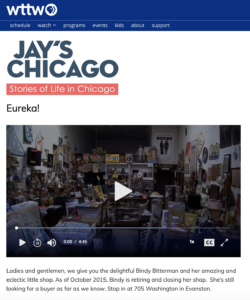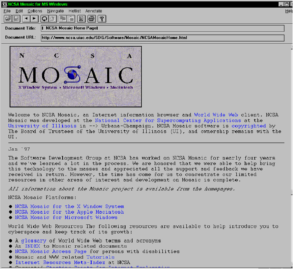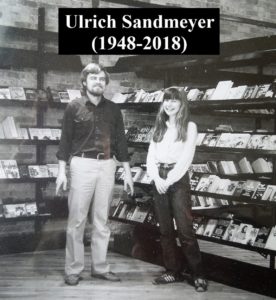Saturdays with Seniors: Bindy at the Jewish USO
November 7, 2020 • 8 Comments • Posted in guest blog, memoir writing, radio, travel
When today’s guest blogger Bindy retired, the local public TV channel, WTTW, did a feature on her and her store, Eureka. Click on the image to see it.
I am pleased to feature Bindy Bitterman as our Saturdays with Seniors guest blogger today. Bindy owned and managed Eureka, an amazing and eclectic little shop in Evanston, Illinois until 2015, when she retired at age 84. She moved to The Admiral at the Lake after that, and is a writer in the memoir class I lead there via Zoom. This Wednesday, November 11, is Veteran’s Day, so I thought it the perfect time to publish this story Bindy wrote about befriending a few veterans during World War II.
So Long to A Beautiful Friendship with an Unlikely Beginning
by Bindy Bitterman
I wish I could find the Chicago Tribune photo: 5 8th graders in 1944. We’d had a rummage sale, and raised enough money to donate a radio/phonograph to the Jewish USO downtown AND sponsor a breakfast there. What a day that was! Marty, Mel, and Al were there, three sailors from New York who’d been assigned teaching duties at Navy Pier. I never saw Al after that day, but Marty and I would become wartime pen pals as he moved on to other tasks at other destinations. And Mel! Gorgeous, wonderful Mel — our connection lasted until he died this year.
From its beginnings on that Sunday in 1944, our friendship expanded to include parents, spouses, and kids, mine and his. It reached from the suburbs of New York, where my husband Richard and I visited them, to our home in Chicago’s Rogers Park, where they visited us. It still continues with his wife, Helen, and his musician son.
I said gorgeous and I meant it. Mel was gorgeous into his 90s, and maybe he still was when he died. But that’s a minor part of his wonderfulness: he was dear. He was deep. He was kind. He was a great father and a great friend. He took life seriously but laughed throughout it. He and Helen loved kids, and when they came to visit ours, they brought their guitar and their kid-friendly songs and jokes and riddles and tongue-twisters (not all of them music to MY ears; some I thought a bit too vulgar). Of course, my kids loved every one of them. And they adored Mel and Helen.
That first day we met, I had taken the three sailors home with me to meet my parents. My mother, all charm and graciousness, immediately won their hearts. A bond developed. Shortly thereafter, when Mel married Helen and brought her to Chicago, the couple started visiting frequently. During a phone conversation Just a month or so ago, Helen reminisced about my parents and their lovely Chicago apartment.
Yes, we’re still in touch. I drop her a line or two on my prettiest note cards every few weeks now.
Because I didn’t for a while.
When my husband Richard died, Mel and Helen were still healthy. But they moved into an assisted living facility in their Long Island area, and shortly thereafter, Mel began showing gradual signs of dementia. I couldn’t bear to think of either of them, but especially Mel, in that condition, but I kept calling every few months as I had done through the years. After a while, though, it became too painful. No calls, no notes.
Their son phoned a few months ago. Mel was gone. A piece of my heart went, too.
But Helen and I are back in touch. She and Mel were married 77 years, I think. She’s well into her 90s, too, but seems pretty chipper.
Didn’t someone in our group say something about putting your sad thoughts in a basket? I need a trunk!

 Not leave home? Being with my writers is what I love most about teaching memoir. Hearing Wanda’s classmates scramble to find her a seat when she arrives; sensing the drama of passing a bag of Scrabble tiles around to determine who picks “Z” out of the bag (usually “A” goes first, but sometimes I go backwards!); Bindy’s delight to hear an assignment that inspires a limerick; Janie reading an essay out loud for a fellow writer whose low vision prevents them from doing so on their own; the collective gasp when Bruce recites a particularly poignant phrase; hearing updates on our new Grail Café from writers who stopped there before coming to the class I lead in the neighborhood; taking in the ooos and ahs whenever Michael brings a show and tell to passs around as he reads his latest essay.
Not leave home? Being with my writers is what I love most about teaching memoir. Hearing Wanda’s classmates scramble to find her a seat when she arrives; sensing the drama of passing a bag of Scrabble tiles around to determine who picks “Z” out of the bag (usually “A” goes first, but sometimes I go backwards!); Bindy’s delight to hear an assignment that inspires a limerick; Janie reading an essay out loud for a fellow writer whose low vision prevents them from doing so on their own; the collective gasp when Bruce recites a particularly poignant phrase; hearing updates on our new Grail Café from writers who stopped there before coming to the class I lead in the neighborhood; taking in the ooos and ahs whenever Michael brings a show and tell to passs around as he reads his latest essay.
